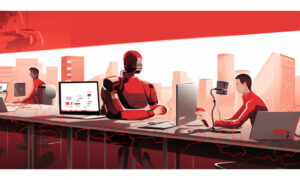Where does HR tech add most value in helping HR support business strategy?
- 6 Min Read
Sharon Looney, CoreHR, examines the tactical advantages technology presents to HR in becoming a strategic arm of business.
- Author: Sharon Looney
- Date published: Feb 27, 2020
- Categories

People ultimately deliver all value in a business. Organisations with strong leaders, highly effective, agile workforces and good ideas thrive. HR clearly has an essential role to play in business outcomes, and yet we have often struggled to align with business priorities and prove our strategic value-add. This is changing, and changing very much for the better.
Enabled by increasingly smart technology, CHROs are stepping up to the mark. They are optimising processes and deliverables to help meet strategic corporate goals. CHRO’s are starting to elevate HR’s role to becoming a function that is no longer an administrative cost centre, but a contributor to market share, customer satisfaction rates, product innovation and the bottom line. All of this, as well as helping the company become more agile as well as a great place to work.
There are two main ways in which HR tech is empowering HR to support business strategy. Firstly, data analytics is now allowing us to combine traditional gut instinct with quantitative evidence to better direct resources towards strategic business needs and to prove its value-add. Secondly, automation is freeing HR teams from many tactical roles, such that we can give time to strategic work, including partnering with leaders across the enterprise to help them achieve their goals.
Smarter decisions with data driven intelligence
According to Fosway Group’s 2019 HR realities research, 68% of companies are increasing their investment in analytics. HR analytics is likely to be the number one area for HR tech investment in 2020.
To date, analytics has mostly been applied to provide intelligence around transactional activity such as spend versus outcomes in areas like compensation, recruitment and retention.
The true value of HR analytics though, comes from putting varied data sets together, making informed decisions and offering timely business advice to guide decision making and thus deliver better outcomes. By combining business and people metrics, HR can better show the relationships between investment in people processes and business outcomes. For example: The value of a new employee onboarding program can be measured in terms of ROI by assessing the costs saved by correlated reductions in staff turnover. And individuals and teams can be empowered to view the contribution they’re making to C-suite defined corporate goals.
Not only can analysis of past decisions and resulting outcomes be used to tune future decisions. Crucially too, such insight provides quantifiable evidence of HR’s value-add to the business. Fosway Group’s research suggests 74% of organisations report a demand from stakeholders for HR to prove its business value.
Define and measure the right things and you can demonstrate without doubt to top executives that a strategic and proactive HR effort delivers significantly more value than a ‘back office’ one. If we prove our worth to senior executives we earn their trust and acceptance. Board-level executives will seek our guidance on their human capital decisions as they seek to maximise business outcomes and the bottom line.
Freedom from routine
As well as helping us make smarter decisions with data driven intelligence, technology is also automating many of the operational activities that once filled every HR professional’s day. The best HR tech suites now roll into a single integrated platform the administrative tasks within payroll, people management, workforce management, recruitment and more.
Consider too, the latest HR innovations in employee ‘self-service’. Many HR tech suites now enable employees to easily access their employment information themselves, often via consumer-style mobile apps, and managers can access and query relevant employee data. Not only does self-service reduce the load on HR staff, but it means staff and their managers can access information when they need it, rather than having to request it from HR and await a response.
Not only is automation making HR more efficient. The fact that it also frees the function from routine means we can undertake the more strategic responsibilities of our role, in particular to partner with leaders across the business.
In the past, HR has done well on driving employee engagement, building credibility with employees and managers, managing performance and simplifying processes. But this is no longer enough. To be a strategic partner to department chiefs and to the Board in today’s dynamic working environment, we need to do more. HR needs to guide human capital decisions, align budgets with desired outcomes, deal with changing demographics, design and redesign career paths, invent dynamic and flexible work arrangements. We need to identify and address skills gaps, spot and manage talent risks, provide competent leaders and steer businesses and people through change and transformation. We need to guide the design of work cultures that make the business both productive and a great place to work. None of these roles is achievable, unless we are freed from routine to partner with the key senior managers in the business and prove that we can be close and trusted advisers.
Let’s go!
The demands and expectations on HR are increasing. The need to improve ROI and increase speed to value is more important than ever. To take advantage of HR tech, many HR teams will need to up-skill as data analysts as well as become competent at presenting analytics at board level. It’s not as tough as it might sound, especially given increasingly user-friendly and consumer-style platforms and our increasingly tech-savvy workforce.
Finally, to make a success of HR tech, we must avoid outsourcing it to IT. It’s up to us to take charge and choose the ‘right’ technology that aligns with our needs, while certainly partnering with IT for technical guidance. Note that accessing data across disjointed systems is inefficient and time-consuming. To ensure accuracy and consistency of data, it is crucial to have a single source of truth (centralised data repository) in order to derive consolidated and meaningful insights and data stories.
With HR technology at our disposal, we have the opportunity to become the strategic people partner our organisations need us to be. The best platforms give us incredible insight, while freeing us to align with corporate goals and prove our value.
About Sharon Looney
Sharon Looney is CPO for technology company CoreHR, where she reports directly to the CEO and is a member of the executive board. A business transformation and change leader, she creates environments in which people excel and firms thrive. Sharon has extensive experience in large-scale transformational change management, leadership development and cultural innovation. She steers organisations and their HR teams to ignite and accelerate delivery of the human aspects of business transformations and has worked in more than 21 countries. Sharon has earned multiple accolades, including in 2019 the CHRO of the Year (Global HRD Congress) and Irish HR Champion awards. In 2018, she was presented with a Top 50 HR Tech Minds Award by the World HRD Congress.









